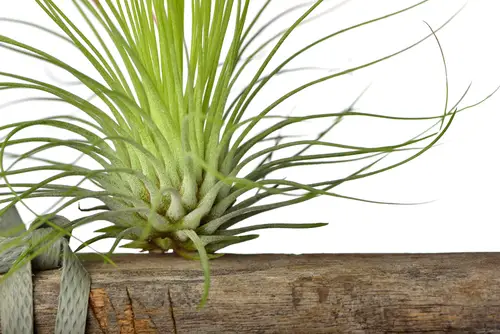Air plants, also known as Tillandsia, are a type of epiphyte that can grow without soil. They are commonly found in tropical regions, including Florida. But where do air plants grow in Florida? Understanding the natural habitats of air plants is essential to their care and maintenance.
Air plants native to Florida include the Giant Airplant, Ball Moss, and Spanish Moss. These plants grow naturally in Florida’s humid and subtropical climate, thriving in areas with high humidity and rainfall.
They are often found growing on trees, rocks, and other surfaces that provide support and moisture. Understanding the natural habitats of air plants can help determine the best care practices for these unique plants.
In addition to their natural habitats, air plants also have unique features and relationships with other organisms, such as ants. By understanding these characteristics, air plant enthusiasts can better care for their plants and appreciate their beauty.
Understanding Air Plants
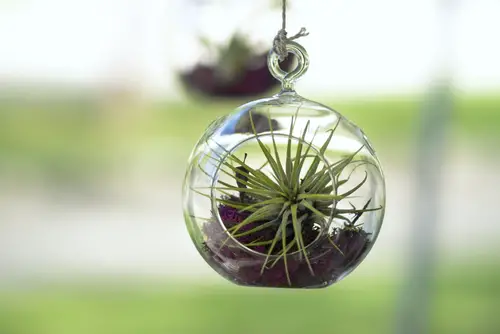
Air plants, also known as Tillandsia, are a type of epiphyte that belongs to the Bromeliad family. They are native to Central and South America, but several species also grow in Florida. These plants are unique in that they do not need soil to grow. Instead, they absorb nutrients and moisture through their leaves.
There are over 500 species of air plants, each with its own unique shape, size, and color. Some of the most popular species include T. fasciculata, T. usneoides, and T. xerographica.
T. fasciculata is a large air plant with green leaves and pink flowers. T. usneoides, also known as Spanish moss, is a grayish-green plant that grows in long, flowing strands. T. xerographica is a large, silvery-gray plant with curly leaves.
Air plants are easy to care for and make great houseplants. They require bright, but not direct, sunlight to thrive. Keep them near a south, east, or west-facing window. Air plants also need good air circulation, so make sure to place them in a well-ventilated area.
In terms of watering, air plants need to be misted with water every few days. You can also soak them in water for 30 minutes once a week. Make sure to shake off any excess water and let them dry completely before putting them back in their container.
Check out these other related posts:
- Where Can You Find The Num Num Plant?
- When to Plant Grass Seed in Idaho?
- Where Can I Get a Jasmine Plant?
Air Plants Native to Florida
Florida is home to many species of air plants, also known as Tillandsia. Some of these species grow wild in Florida, while others have been introduced. Among the native species, Spanish moss (Tillandsia usneoides) is one of the most popular and well-known.
It is a member of the bromeliad family and is characterized by its long, silvery-gray strands that hang from trees and other objects. Spanish moss requires high humidity and good air circulation to thrive. It can grow up to 20 feet in length and produces small, purple flowers.
Another native species of air plant in Florida is the ball moss (Tillandsia recurvata). This plant is also a member of the bromeliad family and is found throughout the state. Ball moss grows on trees, rocks, and other objects and is characterized by its small, round shape.
It can tolerate a wide range of conditions, including drought and high temperatures. In addition to Spanish moss and ball moss, there are several other species of air plants that are native to Florida.
These include the northern needleleaf (Tillandsia setacea), potbelly airplant (Tillandsia paucifolia), and cardinal airplant (Tillandsia fasciculata). These plants grow in a variety of habitats, including pine rocklands, hammocks, and mangrove swamps.
Unfortunately, some species of air plants in Florida are endangered due to a Mexican Bromeliad Weevil attack that occurred many years ago.
This weevil feeds on the bromeliad family, including Tillandsia spp., and has caused significant damage to populations of these plants in Florida. Despite this threat, efforts are being made to protect and conserve these unique and important species.
Air Plants’ Natural Habitats
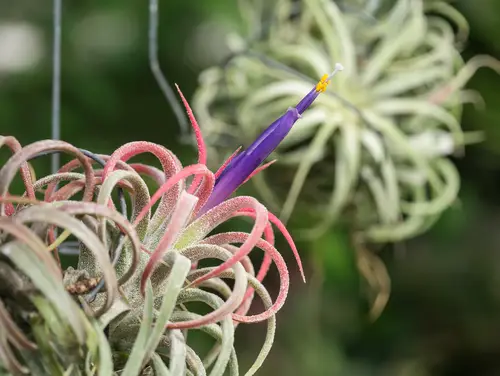
Air plants, also known as Tillandsia, are native to Florida and can be found growing in a variety of habitats. These unique plants have evolved to survive without soil and can be found growing on trees, rocks, cacti, and other substrates.
In Florida, air plants can be found in a range of different habitats, from the humid rainforests of the Everglades to the dry deserts of the western part of the state. They can be found growing on tree branches, in the shade of oak trees, and in mesic and xeric environments.
Air plants require high humidity and good air circulation to thrive. They can be found growing in the wild in the southern region of the state, particularly in the Everglades. The USDA Hardiness Zone for Florida ranges from 8a to 11, which means that air plants can grow in a variety of different climates and temperatures.
In their natural habitats, air plants can be found growing on a variety of different substrates, including rocks, tree branches, and other plants. They are often found growing in clusters, which helps to protect them from the elements and provide them with the necessary humidity and air circulation they need to survive.
Understanding Epiphytes
Epiphytes are plants that grow on other plants or structures, but do not rely on them for nutrients. Instead, they absorb nutrients from the atmosphere and rainwater. They are found in many plant groups, including aroids, begonias, bromeliads, heaths, nightshades, orchids, ferns, and true mosses.
Air plants, also known as Tillandsia, are a type of epiphyte commonly found in Florida. They are part of the bromeliad family and have adapted to absorb nutrients through their trichomes, which are small scales on their leaves that help them absorb water and nutrients from the air.
Epiphytes are able to grow in a variety of environments, including tropical rainforests, deserts, and even on buildings in urban areas. They are able to survive in these environments because they are able to absorb nutrients from the atmosphere and rainwater.
In Florida, epiphytes are commonly found in trees, especially in oak trees and cypress trees. Spanish moss, a type of epiphyte, is often seen hanging from the branches of these trees. Other epiphytes found in Florida include bromeliads, staghorn ferns, bird’s nest ferns, and resurrection ferns.
Air Plants and Their Relationship with Ants
Air plants, also known as Tillandsias, are epiphytes that grow on other plants, rocks, and shrubs, rather than rooting in the ground. In Florida, air plants can be found growing on live oak trees, cypress trees, and other host plants.
Ants are a common sight in Florida and they have a unique relationship with air plants. Ants are attracted to the sweet nectar that air plants produce and they help to pollinate the plants by carrying pollen from one plant to another. In return, the ants receive a source of food from the air plants.
However, not all ants have a positive relationship with air plants. Some ants, such as the invasive Argentine ant, can be harmful to air plants. These ants will often build nests in the base of air plants, which can cause damage to the plant and eventually lead to its death.
To prevent damage to air plants, it is important to control ant populations around air plant colonies. This can be done by using ant baits or by physically removing ant nests from the base of air plants.
Geographical Distribution of Air Plants
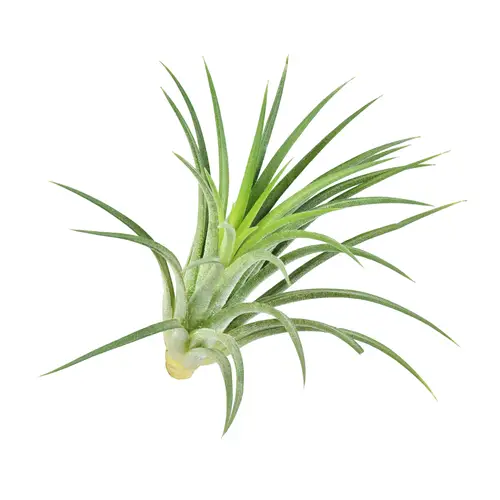
Air plants are native to the tropical and subtropical regions of Central and South America, Mexico, West Indies, and southern United States. They are found in a variety of habitats, including rainforests, deserts, and mountains.
In Florida, air plants are commonly found in coastal areas, where they grow on trees, rocks, and other surfaces. Tillandsia usneoides, also known as “Spanish Moss,” and Tillandsia recurvata, often known as “Ball Moss” by botanists, are two of the most common species found in the region of Tampa Bay.
In Central and South America, air plants are found in a wide range of habitats, from the Amazon rainforest to the Andes Mountains. Some species are adapted to dry, desert-like conditions, while others thrive in humid, tropical environments.
In Mexico, air plants are found in the northern part of the country, where they grow in the Chihuahuan Desert. They are also found in the southern part of Mexico, in the Yucatan Peninsula, where they grow in tropical rainforests.
In Peru, air plants are found in the northern and central parts of the country, where they grow in the Andes Mountains. They are also found in the Amazon rainforest, in the eastern part of the country.
In Ecuador, air plants are found in the western part of the country, where they grow in the Andes Mountains. They are also found in the Amazon rainforest, in the eastern part of the country.
Air Plants’ Growth and Reproduction
Air plants, also known as Tillandsia, are epiphytes that grow without soil. They absorb water and nutrients through their leaves and can be found growing on trees, rocks, and other surfaces. In Florida, air plants grow natively in the wild in the Everglades, particularly in the southern region of the state.
1. Light
Tillandsia needs bright, but not direct, sunlight to thrive. They should be kept near a south, east, or west window if grown indoors. Outside, air plants will thrive in an area of the landscape where they will receive light shade and protection from direct sun.
2. Water
Air plants require regular watering to survive. They should be misted with water every few days or soaked in water for 30 minutes once a week. It is important to allow the plant to dry completely after watering to prevent rotting. When watering, it is recommended to use rainwater or distilled water to prevent mineral buildup on the leaves.
3. Flowering and Reproduction
Air plants’ life cycle has three stages: flower, offsets (or pups), and seeds. When air plants reproduce, they will bloom once and produce offsets. The flowers are typically small and come in a variety of colors, including pink, purple, and red.
After the plant has bloomed, it will produce offsets, which can be removed and used to propagate new plants. Air plants can also be propagated by seeds, but this method is less common.
4. Pups
Offsets, also known as pups, are miniature versions of the parent plant that grow from the base of the plant. They can be removed once they are about one-third the size of the parent plant and have developed their own roots. Pups can be left attached to the parent plant to form a clump or removed to grow a new plant.
Care for Air Plants

Air plants, also known as Tillandsia, are unique and fascinating plants that can be grown indoors or outdoors in Florida. They are epiphytes, which means they grow on other plants or objects, and do not require soil to grow. Proper care is essential to keep air plants healthy and thriving.
1. Light
Air plants require bright, indirect light to grow. Direct sunlight can burn the leaves and cause damage to the plant. In Florida, air plants can be grown indoors near a south, east, or west-facing window. Outdoors, they can be grown in an area that receives light shade and protection from direct sun.
2. Water
Watering air plants is different than watering other houseplants. Most air plants can be successfully watered using a soaking method, where the plant is left to soak in a bowl of distilled water for 20 to 40 minutes every 1 to 2 weeks. The frequency of watering depends on the humidity level, temperature, and air circulation in the environment. Overwatering can lead to root rot and other issues, so it is important to allow the plant to dry completely before watering again.
3. Air Circulation
Air plants require good air circulation to thrive. They can be grown outdoors in Florida, but it is important to protect them from strong winds and rain. If grown indoors, the plant should be placed in a location with good air circulation.
Air plants can also be grown in terrariums, but it is important to ensure that the terrarium has proper ventilation to prevent the buildup of moisture.
4. Temperature
Air plants can tolerate a wide range of temperatures, but they prefer temperatures between 50 and 90 degrees Fahrenheit. In Florida, air plants can be grown outdoors year-round, but it is important to protect them from frost and freezing temperatures.
5. Fertilizer
Air plants do not require fertilizer, but they can benefit from occasional fertilization. A water-soluble fertilizer can be added to the soaking water once a month during the growing season. It is important to use a fertilizer specifically formulated for air plants, as other fertilizers can burn the leaves and damage the plant.
Unique Features of Air Plants
Air plants, also known as Tillandsia, are unique and fascinating plants that have captured the attention of many plant enthusiasts. They are members of the pineapple family and are perennial herbs that grow without soil. Here are some of the unique features of air plants:
- They don’t need soil to grow: Air plants are epiphytes, which means they grow on other plants or objects. They use their roots to anchor themselves to trees, rocks, driftwood, or other objects, but they don’t rely on soil for nutrients.
- They are compact: Air plants are small and compact, making them perfect for small spaces. They can grow up to 12 inches in height and width, but most of them are much smaller.
- They come in different shapes and colors: Air plants come in a variety of shapes and colors, from silvery-gray to bright green. Some species have long, thin leaves, while others have plump, round leaves. They can also bloom in different colors, including pink, purple, red, and yellow.
- They are easy to care for: Air plants are low-maintenance plants that don’t require much attention. They need bright, indirect light and occasional misting or soaking in water. They can also be grown in glass globes, shells, cork, bark, or pebbles.
- They can be used in different ways: Air plants can be used to add greenery to any space. They can be displayed on live oak branches, wire frames, or glass globes. They can also be used in terrariums or mounted on driftwood.
One species of air plant that is unique to Florida is the Catopsis berteroniana. It is a compact plant that grows on live oak trees and can be found in hammocks and swamps. It has thin, silvery-gray leaves and can bloom in pink or purple flowers.
Frequently Asked Questions
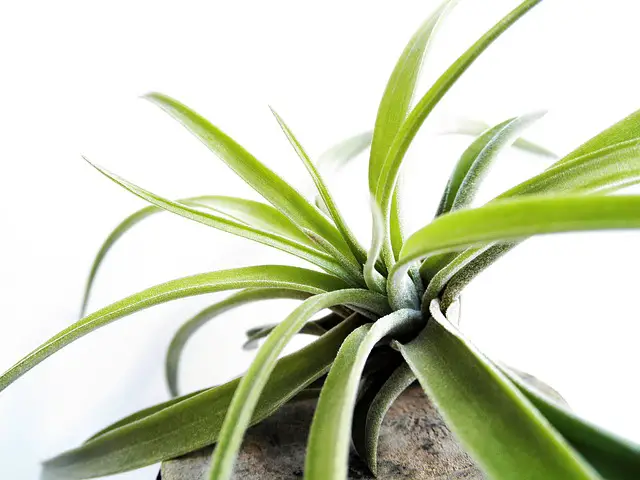
What are the best Florida native bromeliads for air plants?
Florida is home to many native bromeliads that make great hosts for air plants. Some of the best options include Spanish moss (Tillandsia usneoides), ball moss (Tillandsia recurvata), and the giant airplant (Tillandsia utriculata).
How do air plants get nutrients in Florida?
Air plants in Florida get their nutrients from the surrounding environment. They absorb moisture and nutrients through their leaves, which allows them to live without soil. In Florida, air plants can get nutrients from rain, dew, and even the humidity in the air.
Are there any legal restrictions on taking air plants in Florida?
Yes, it is illegal to remove air plants from the wild in Florida without a permit. The Florida Department of Agriculture and Consumer Services regulates the harvest and sale of air plants to protect these native species.
What are some large air plants that can be found in Florida?
Florida is home to several large air plants, including the giant airplant (Tillandsia utriculata), which can reach up to six feet in height. Other large air plants found in Florida include the cardinal airplant (Tillandsia fasciculata) and the ball moss (Tillandsia recurvata).
Do air plants thrive in the Florida climate?
Yes, air plants can thrive in the Florida climate. They are well-adapted to the warm, humid conditions found in the state. However, it is important to provide them with the right growing conditions, including bright but indirect light, good air circulation, and regular misting or watering.
Where can I find wild air plants in Florida?
Wild air plants can be found growing on trees, rocks, and other surfaces throughout Florida. They are most commonly found in coastal areas, pine forests, and hammocks. However, it is important to remember that it is illegal to remove air plants from the wild without a permit.

Hey, I’m Lisa and I’ve been an avid gardener for over 30 years. I love writing, talking and living in the garden! Feel free to connect with me on my socials below

